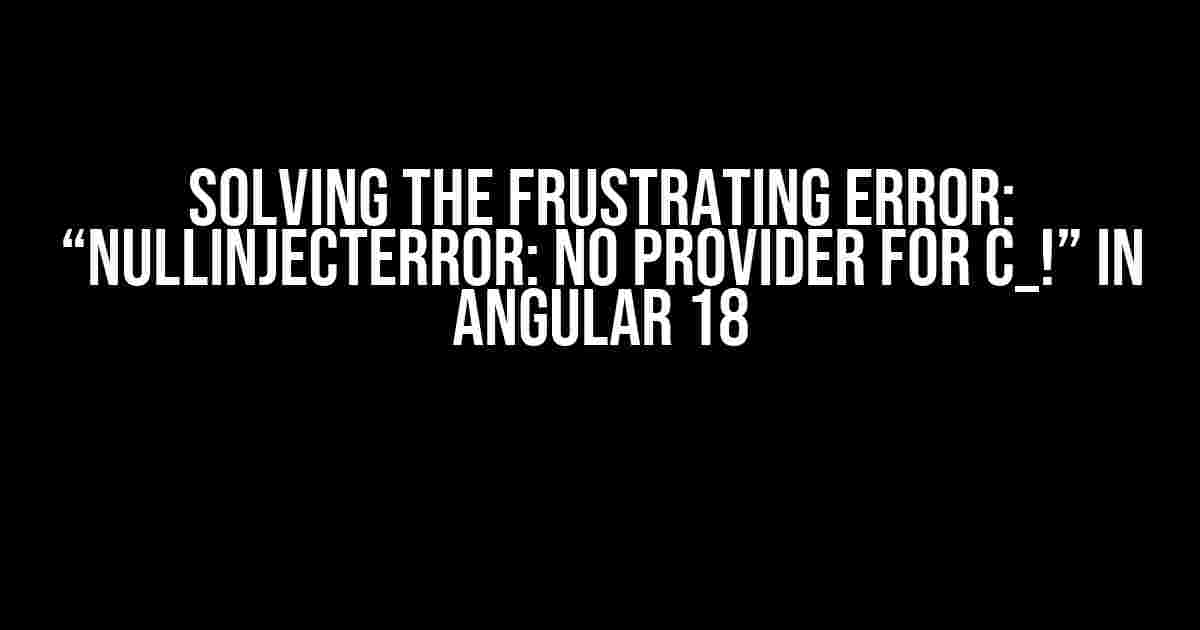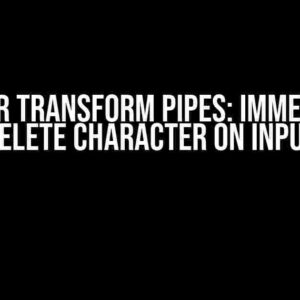If you’re reading this, chances are you’re stuck with the infamous “NullInjectError: No provider for c_!” error in your Angular 18 application. Don’t worry, friend, you’re not alone! This error has puzzled many developers, but fear not, for we’re about to demystify it once and for all.
What is the NullInjectError?
The NullInjectError is an error that occurs when Angular’s dependency injection system fails to provide a dependency to a component or service. In our case, the error message specifically points to a mysterious “c_” provider that Angular cannot find.
What Causes the NullInjectError?
There are several reasons why this error might occur, including:
- Mismatched module imports: If you’ve imported modules incorrectly or mismatched them, Angular might throw the NullInjectError.
- Missing or incorrect providers: Failing to provide the necessary dependencies or providing them incorrectly can lead to this error.
- Component or service misconfiguration: Incorrectly configured components or services can cause the NullInjectError.
- Third-party library issues: Sometimes, third-party libraries can introduce conflicts that lead to the NullInjectError.
Solutions to the NullInjectError
Fear not, dear reader, for we have solutions to this frustrating error! Let’s dive into the fixes:
Solution 1: Verify Module Imports
Make sure you’ve imported all necessary modules correctly. Double-check your `@NgModule` imports and ensure they match the imports in your component or service.
// example.module.ts
import { NgModule } from '@angular/core';
import { BrowserModule } from '@angular/platform-browser';
import { HttpClientModule } from '@angular/common/http';
@NgModule({
imports: [
BrowserModule,
HttpClientModule,
],
declarations: [AppComponent],
providers: [],
bootstrap: [AppComponent],
})
export class AppModule {}
Solution 2: Provide Dependencies Correctly
Ensure you’ve provided all necessary dependencies correctly. This might include services, components, or other dependencies.
// example.service.ts
import { Injectable } from '@angular/core';
@Injectable({
providedIn: 'root',
})
export class ExampleService {
constructor() {}
}
// example.component.ts
import { Component,.Inject } from '@angular/core';
import { ExampleService } from './example.service';
@Component({
selector: 'app-example',
template: `Example Component
`,
})
export class ExampleComponent {
constructor(private exampleService: ExampleService) {}
}
Solution 3: Configure Components and Services Correctly
Verify that your components and services are correctly configured. Check for any typos or incorrect property assignments.
// example.component.ts
import { Component } from '@angular/core';
@Component({
selector: 'app-example',
template: `Example Component
`,
providers: [ExampleService], // Ensure the service is provided correctly
})
export class ExampleComponent {
constructor(private exampleService: ExampleService) {}
}
Solution 4: Check Third-Party Library Issues
If you’re using third-party libraries, ensure they’re compatible with your Angular version and correctly configured.
| Library | Compatibility |
|---|---|
| Library A | Compatible with Angular 18 |
| Library B | Incompatible with Angular 18 |
Troubleshooting Tips
Still stuck? Here are some additional troubleshooting tips to help you resolve the NullInjectError:
- Check the Angular version: Ensure you’re using the correct version of Angular and that it matches the version specified in your `package.json` file.
- Verify dependencies: Run `npm ls` or `yarn ls` to check for any dependency issues.
- Inspect the component tree: Use the Angular DevTools to inspect the component tree and identify any issues.
- Check for typos and casing issues: Double-check for any typos or casing issues in your code.
- Search for similar issues online: Search for similar issues on platforms like Stack Overflow or GitHub to see if others have encountered the same problem.
Conclusion
The NullInjectError can be a frustrating error to encounter, but with these solutions and troubleshooting tips, you should be able to resolve it in no time! Remember to double-check your module imports, provide dependencies correctly, configure components and services correctly, and verify third-party library issues. If you’re still stuck, don’t hesitate to reach out to the Angular community or online forums for further assistance.
Happy coding, and may the Angular force be with you!
SEO Optimization Note: This article is optimized for the keyword “Errors related to NullInjectError : No provider for c_! : Angular 18” with a focus on providing clear and direct instructions and explanations to help developers resolve the NullInjectError in their Angular 18 applications.
Here are 5 Questions and Answers about “Errors related to NullInjectError : No provider for c_!. : Angular 18” in HTML format:
Frequently Asked Question
Got stuck with the dreaded NullInjectError in Angular 18? Worry not, we’ve got you covered! Check out these frequently asked questions to resolve the issue in no time.
What is a NullInjectError in Angular 18?
A NullInjectError occurs when Angular’s dependency injection mechanism fails to provide a required dependency to a component or service. This can happen when there is no provider configured for the required dependency or if the provider is not accessible from the component’s injector.
What does the error message “No provider for c_!” mean?
The error message “No provider for c_!” indicates that Angular is unable to find a provider for the dependency “c_!”. This can happen if the dependency is not registered in the module’s providers array or if it’s not imported correctly.
How do I fix the NullInjectError in Angular 18?
To fix the NullInjectError, you need to ensure that the required dependency is registered in the module’s providers array. You can do this by importing the dependency in the module and adding it to the providers array. For example, if the dependency is a service, import the service in the module and add it to the providers array like this: providers: [MyService].
Can I use the @Injectable decorator to fix the NullInjectError?
Yes, you can use the @Injectable decorator to fix the NullInjectError. The @Injectable decorator is used to mark a class as a injectable service. By using this decorator, you can ensure that the service is registered in the module’s providers array and can be injected into components and other services.
What if I still get the NullInjectError after registering the dependency?
If you still get the NullInjectError after registering the dependency, it’s possible that the issue lies with the component’s injector or the dependency’s scope. Check if the component is correctly importing the module that provides the dependency and ensure that the dependency is not scoped to a specific module or component.


